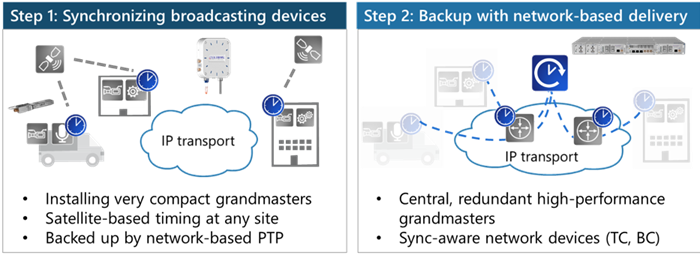The National Association of Broadcasters (NAB) Show is the number one place to discuss technology innovation for the entertainment industry. Last month, I was pleased to be at NAB Show New York, chatting to attendees at our booth and presenting the detail of our new solution for next-generation broadcast network synchronization.
It was fascinating to talk to so many key players in the world of broadcasting about their needs. Speaking with folk from the likes of ABC and Disney as well as service providers such as AT&T and Verizon, I was encouraged to hear that the key challenges they’re facing are the precise ones we’ve been focusing on. In fact, our latest offering is exactly what media networks need to go to the next level.
The transformation taking place in broadcast networking is the same one we can see across all industries. To take advantage of lower cost and flexibility, monolithically integrated, proprietary applications are steadily being replaced by common multi-purpose hardware with open software and standardized interfaces.
In the world of broadcasting, this can mean an end to expensive satellite links, dedicated point-to-point SDI networks and an army of specialist staff being deployed to every live event. The benefits of media network IP-ification are huge. However, the transition does raise some fundamental timing challenges.
The shift towards IP replaces synchronous transport networks with asynchronous technology, leading to SDI signals being broken down into multiple independent video, audio and metadata streams. To ensure high quality – and avoid lip sync alignment issues – networks and paths must be engineered to introduce as little packet delay variation (also known as jitter) as possible.
This means each stream must be accurately aligned, with the frequency and phase of the sending and receiving network elements tightly synchronized to avoid frame drops. For audio, video and metadata streams to be flexibly processed, packets traveling over the switched IP infrastructure need precise timestamping. This enables the packets to be recovered in the right order and then realigned to avoid impairments and maintain quality of service. What’s more, for accurate delivery of packetized content and PTP timestamps, packet networks must be fully time-aware.
All of this calls for a new approach to broadcast network timing.
A new standard
To make the deployment and implementation of packet technology as easy as possible, the Society of Motion Picture and Television Engineers (SMPTE) has created a family of specifications for synchronizing audio, video and media data over an IP network. IEEE 1588 was chosen for the delivery of accurate time and frequency information. Based on this, SDI formats can be converted into independent, PTP timestamped IP content streams, and local sync-pulse generators can be replaced by this standardized IP timing technology.
To ensure that content created in IP can be produced, edited and transmitted with the high-resolution needed to meet growing quality of service expectations, sync technology must be fully compliant with these SMPTE and IEEE standards. Time sources also need to be affordable, scalable and highly flexible. This would enable the seamless migration from established SDI architectures to future-proof IP networking.
For precise synchronization, compact GNSS-based grandmasters can be installed at all production and broadcast sites. This enables accurate time to be delivered easily and affordably to any site. The IP network’s time delivery capabilities can then be harnessed to back up the satellite-based time at the edge, with PTP timing delivered to multiple slave clocks by high-performance core grandmasters.

Time for better broadcast and production networks
The good news is that compact and versatile grandmasters are easy to deploy and our Oscilloquartz product portfolio has been specifically optimized for this application.
Our OSA 5401, is the industry’s smallest SFP-based grandmaster. It can easily be plugged into the interface port of a local switch. Or, if an integrated grandmaster with a GNSS receiver and antenna is required, our OSA 5405 provides an incredibly simple solution for satellite-based, highly accurate time and frequency reference.
Also, for ultimate availability and reliability, complementing GNSS-based timing with PTP-enabled timing at the edge is key. Our technology range offers a wide portfolio of core and edge grandmaster clocks with synchronization quality of service measurement and monitoring capabilities as well as built-in jamming and spoofing detection powered by AI-based analytics.
With our unique portfolio, even remote studios and mobile sites connected to production and broadcast sites over public or private networks can benefit from low-cost, assured sub-microsecond synchronization.
